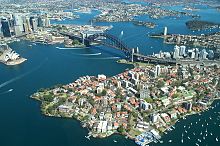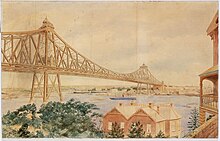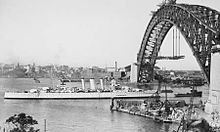Sydney Harbour Bridge
[1][2] Under the direction of John Bradfield of the New South Wales Department of Public Works, the bridge was designed and built by British firm Dorman Long of Middlesbrough, and opened in 1932.
[21] Some 250 Australian, Scottish, and Italian stonemasons and their families relocated to a temporary settlement at Moruya, 300 km (186 mi) south of Sydney, where they quarried around 18,000 m3 (635,664 cu ft) of granite for the bridge pylons.
[6][30] In 1825, Greenway wrote a letter to the then "The Australian" newspaper stating that such a bridge would "give an idea of strength and magnificence that would reflect credit and glory on the colony and the Mother Country".
[30] In 1900, the Lyne government committed to building a new Central railway station and organised a worldwide competition for the design and construction of a harbour bridge, overseen by Minister for Public Works Edward William O'Sullivan.
[33] A unique three-span bridge was proposed in 1922 by Ernest Stowe with connections at Balls Head, Millers Point, and Balmain with a memorial tower and hub on Goat Island.
His confidential secretary Kathleen M. Butler handled all the international correspondence during his absence, her title belying her role as project manager as well as a technical adviser.
[3][30] The arch design was cheaper than alternative cantilever and suspension bridge proposals, and also provided greater rigidity making it better suited for the heavy loads expected.
Both sets of rail tracks were linked into the underground Wynyard railway station on the south (city) side of the bridge by symmetrical ramps and tunnels.
This friction ultimately led to a large contemporary brass plaque being bolted very tightly to the side of one of the granite columns of the bridge to makes things clear.
[41] The official ceremony to mark the turning of the first sod occurred on 28 July 1923, on the spot at Milsons Point where two workshops to assist in building the bridge were to be constructed.
To stabilise works while building the arches, tunnels were excavated on each shore with steel cables passed through them and then fixed to the upper sections of each half-arch to stop them collapsing as they extended outwards.
Several more were injured from unsafe working practices undertaken whilst heating and inserting its rivets, and the deafness experienced by many of the workers in later years was blamed on the project.
Henri Mallard between 1930 and 1932 produced hundreds of stills[52] and film footage[53] which reveal at close quarters the bravery of the workers in tough Depression-era conditions.
Among the tradesmen interviewed were drillers, riveters, concrete packers, boilermakers, riggers, ironworkers, plasterers, stonemasons, an official photographer, sleepcutters, engineers and draughtsmen.
[citation needed] A similar ribbon-cutting ceremony on the bridge's northern side by North Sydney's mayor, Alderman Primrose, was carried out without incident.
[61] A message from a primary school in Tottenham, 515 km (320 mi) away in rural New South Wales, arrived at the bridge on the day and was presented at the opening ceremony.
The Bradfield Highway is designated as a Travelling Stock Route[68] which means that it is permissible to herd livestock across the bridge, but only between midnight and dawn, and after giving notice of intention to do so.
[94][95] On 7 December 2016 the NSW Roads Minister Duncan Gay confirmed that the northern stairway would be replaced with a A$20 million ramp alleviating the needs for cyclists to dismount.
[18] One notable identity from previous bridge-painting crews is Australian comedian and actor Paul Hogan, who worked as a bridge rigger before rising to media fame in the 1970s.
[102] The robots, nicknamed Rosie and Sandy,[103] are intended to reduce workers' potential exposure to dangerous lead paint and asbestos and the blasting equipment which has enough force to cut through clothes and skin.
[105] He installed a number of attractions, including a café, a camera obscura, an Aboriginal museum, a "Mother's Nook" where visitors could write letters, and a "pashometer".
The main attraction was the viewing platform, where "charming attendants" assisted visitors to use the telescopes available,[105] and a copper cladding (still present) over the granite guard rails identified the suburbs and landmarks of Sydney at the time.
[106] The outbreak of World War II in 1939 saw tourist activities on the bridge cease, as the military took over the four pylons and modified them to include parapets and anti-aircraft guns.
[117][118] Australia's bicentennial celebrations on 26 January 1988 attracted large crowds in the bridge's vicinity as merrymakers flocked to the foreshores to view the events on the harbour.
[citation needed] The Harbour Bridge has been an integral part of the Sydney New Year's Eve celebrations, generally being used in spectacular ways during the fireworks displays at 9pm and midnight.
[126] An initiative of the Historic Houses Trust, the exhibition featured dramatic photographs and paintings with rare and previously unseen alternative bridge and tunnel proposals, plans and sketches.
[143] There the proud arch Colossus like bestrideYon glittering streams and bound the strafing tide.I open this bridge in the name of His Majesty the King and all the decent citizens of NSW.To get on in Australia, you must make two observations.
No Australian will admit this....in a gesture of anomalous exhilaration, at the worst time of the depression Sydney opened its Harbour Bridge, one of the talismanic structures of the earth, and by far the most striking thing ever built in Australia.
The walls are physical evidence that a number of 19th century residences existed on the site which were resumed and demolished as part of the Sydney Harbour Bridge construction".
"The archaeological remains have some potential to yield information about the previous residential and commercial occupation of Milsons Point prior to the construction of the Sydney Harbour Bridge transport link".































